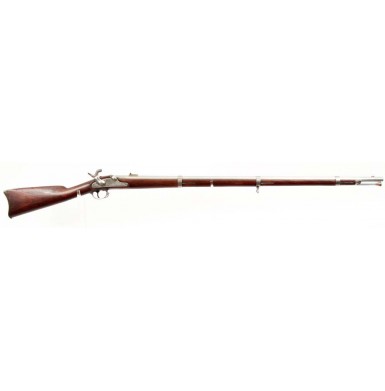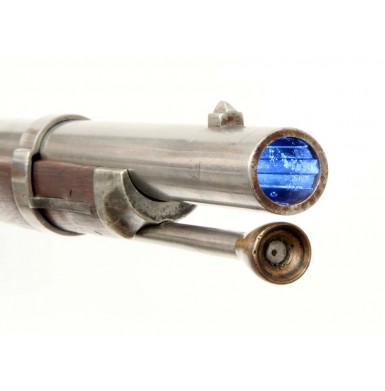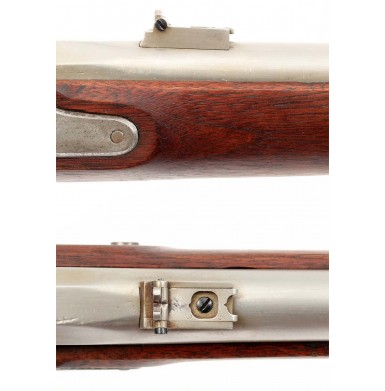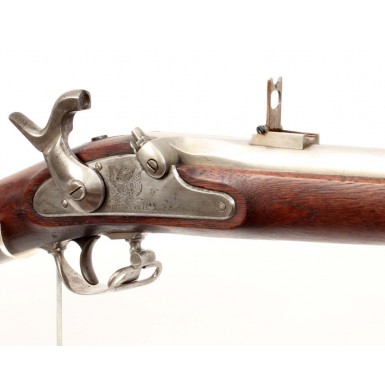1st Contract Whitney Connecticut Rifle Musket
- Product Code: FLA-2141-SOLD
- Availability: Out Of Stock
-
$1.00
The arms manufactured by Eli Whitney Jr.’s Whitney Armory in New Haven, CT are some of the most interesting and intriguing arms produced for use prior to and during the American Civil War. The Whitney arms manufacturing business was historic in being one of the first large scale manufactories erected in the United States, applying the principles of assembly line production to the manufacture of small arms. From the earliest part of the 1800’s, Eli Whitney and his decedents had produced arms on contract for both the United States Federal government, as well as many of the individual states. It was the contract for the production of M-1841 “Mississippi” Rifles that nearly ruined the company, and Eli Whitney Jr. would opine that the need to manufacture the guns on such tight tolerances, with fully interchangeable parts ended up costing the company more per rifle than the US government paid for them. As a result, in the 1850’s Whitney started to experiment with the production of what he termed “Good & Serviceable” arms, guns that essentially followed US military patterns, but were not made to the tight, interchangeable parts tolerances of US government work, and would not be subjected to “inspection with gauges”. Whitney found a ready market for these arms, as he could deliver them quickly and lower prices than were typically charged for similar weapons, so long as the buyer was not too picky about minor imperfections, non-interchangeable parts, and some minor variations in features such as sights, rifling, ramrods, bayonets, etc. With the coming of the American Civil War, the state of Connecticut became one of Whitney’s largest clients. Initially they purchased 350 of his M-1855 “Whitney Variant” rifle muskets, and quickly placed an order for 6,000 of his .58 “Good & Serviceable” rifle muskets. This order was placed on June 27, 1861, and the agreed upon price was $18.00 per stand of arms. This was $2.00 cheaper than the contract price Whitney charged the US government, but then the Connecticut arms were not manufactured to US Ordnance Department standards. The guns exhibited a number of minor differences in features. They utilized Whitney’s simplified “mid-range” rear sight, with a simple L-shaped leaf with a pierced aperture for longer range shooting, rather than the multi-leaf arrangement found on US M-1861 rifle muskets. The guns were delivered with steel shanked ramrods with brass tips of Whitney’s design and likely manufacture. Some of the guns utilized condemned parts that Whitney had purchased at government auctions and from other contractors. The barrels came from a variety of sources including US contractors like Washburn, as well as foreign makers, like James & Ezra Millward of Birmingham England. The barrels were typically rifled with Whitney’s 7-groove rifling, not the typical US regulation 3-groove, and many of the bayonets supplied were of the Enfield P-1853 pattern and were acquired from abroad as well. While all of these shortcuts allowed Whitney to produce the arms faster and at a lower cost to the state of Connecticut, the customer was not always happy. As Whitney completed his deliveries under this initial contract for 6,000 arms in July of 1862, the state of Connecticut offered him a second contract for 8,000 arms at the same price, with the caveat that that the ramrods were to have steel heads, not brass, that the bayonets were to by of US M-1855 pattern and not Enfield pattern. The biggest complaint lodged by the state was regarding the irregularity of the barrel diameters and bayonet sockets, which precluded the interchangeability of bayonets form musket to musket. It appears that the state also wanted to avoid the 7-groove rifling and imported barrels, as Whitney agreed to furnish the 2nd contract guns with all US manufactured parts, if Connecticut would accept 1000 to 1200 of them with English barrels. This suggests that he simply wanted to use up the remaining stock of these barrels. Interestingly, it appears Whitney only honored the promise on the surface, as he acquired some 4,060 “American Pattern Barrels’ from the Colt Patent Arms Manufacturing Company, which had all be manufactured by Millward in England! As with the first contract, Whitney supplied the guns quickly, and by mid-March of 1863 all 8,000 had been delivered and accepted. According to research by Howard Madaus and George Moller, Whitney muskets are known to have been issued to the 13th, 14th, 15th, 16th, 18th, 20th, 21st, 22nd and 27th regiments of Connecticut state infantry. There is no doubt that some other Connecticut regiments must have received at least a few of the contract arms as well.
This Whitney Connecticut Contract .58 Rifle Musket is from the first contract and is one of the arms delivered sometime no later than the summer of 1862. The gun is in about FINE overall condition, and appears to be 100% complete and correct in every way for a Whitney Connecticut 1st Contract Rifle Musket. The gun is assembled with the classic Whitneyville lock, so often encountered on Whitney M-1861 Naval (aka “Plymouth”) rifles. The lock is undated, and is crisply stamped with a spread-winged Eagle over a panoply of flags & arms, forward of the hammer, all of which is over the word WHITNEYVILLE in a shadow-like, double lined font. The buttplate tang is unmarked, as is appropriate for a Whitney “Good & Serviceable” rifle musket, and the barrel bands are correctly marked with U, “up” marks on their right sides. The gun has a more traditional M-1861 style bolster with a clean out screw, and is probably one of the barrel supplied by a US contractor like Washburn. The barrel is marked with the usual Whitney alphanumeric on the top of the barrel, behind the front sight. The mark is A / 10. The front sight/bayonet lug appears to have been modified by Whitney to insure it would accept a standard US M-1855 socket bayonet. The earlier contract guns often had sight/lugs that were too wide for the use of US socket bayonets. The barrel bears no inspection, view or proof marks, which is not uncommon on Whitney state contract arms. As the gun is a 1st contract, early production gun, the barrel is rifled Whitney’s usual 7-groove rifling. The gun has the usual Whitney pewter forend cap. The gun has the correct early production pattern Whitney “mid-range” pierced-aperture rear sight with graduations for use at 100, 300 and 500 yards. These early sights had lower sides and provided very little protection for the L-shaped sight leaf. The later production sights had higher sides that protected the leaf, with the sides extending up to the height of the lowest leaf. The gun has its correct, original Whitney straight shank, steel ramrod with a brass tulip shaped head. These rods preformed badly in the field, and were specifically excluded from the 2nd contract. It is difficult to find an original, full length and correct Whitney brass tipped rod. The barrel of the gun has been lightly cleaned a fairly bright, steel-gray patina overall, with some very small scattered patches of lightly oxidized age discoloration. The metal is almost entirely smooth with only some very small, scattered areas of minor pinpricking; mostly around the breech and bolster area and near the muzzle. The bore of the rifle musket is in VERY FINE+ condition. It is mostly bright and has 7 crisply rifled grooves. The bore shows only some very lightly scattered pinpricking along its length. The lock of the rifle musket functions perfectly, is very crisp and is in excellent mechanical condition. The original rear sight functions correctly and smoothly and both of the original sling swivels are in place on the gun. The original and correct Whitney steel and brass ramrod is in place in the ramrod channel. The stock of the musket is in about VERY FINE condition as well and is full length and solid. There are no breaks or repairs, and the stock does not appear to have ever been sanded. The stock retains extremely sharp and crisp lines and edges, especially on the flat, opposite the lock. The stock bears no inspection marks or cartouches, which is correct for these “Good & Serviceable” arms. The stock shows a handful of bumps and dings, as would be expected from a rifle musket that probably saw service and use, but is really in wonderfully sharp condition. The only stock issue worth noting is that the toe of the buttplate is somewhat proud of the toe of the stock. This is not from sanding or shrinkage, but appears to simply be poor fitting from the original manufacture of the musket.
Overall this is a really crisp example of one of the less often encountered Whitney variant “Good & Serviceable” rifle muskets, manufactured on contract for the state of Connecticut. This is one of the 6,000 guns from the smaller and harder to locate 1st contract. The gun has all of the correct early production / 1st contract features and really displays well. This would be a wonderful addition to any collection of American Civil War long arms, and would be especially at home in a display that centers upon the State of Connecticut in the Civil War.







